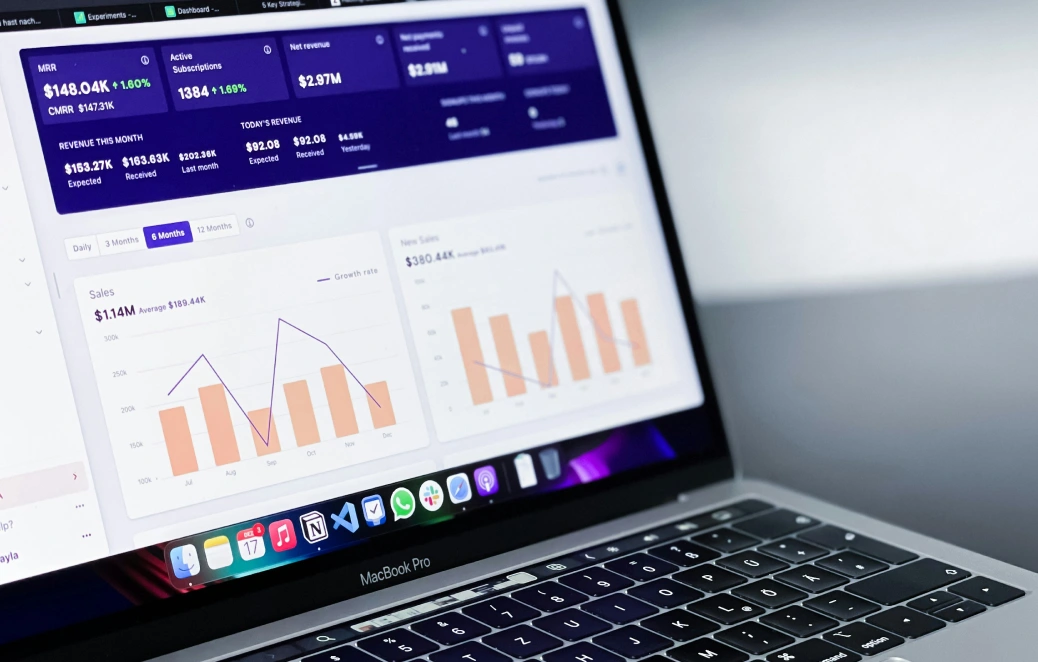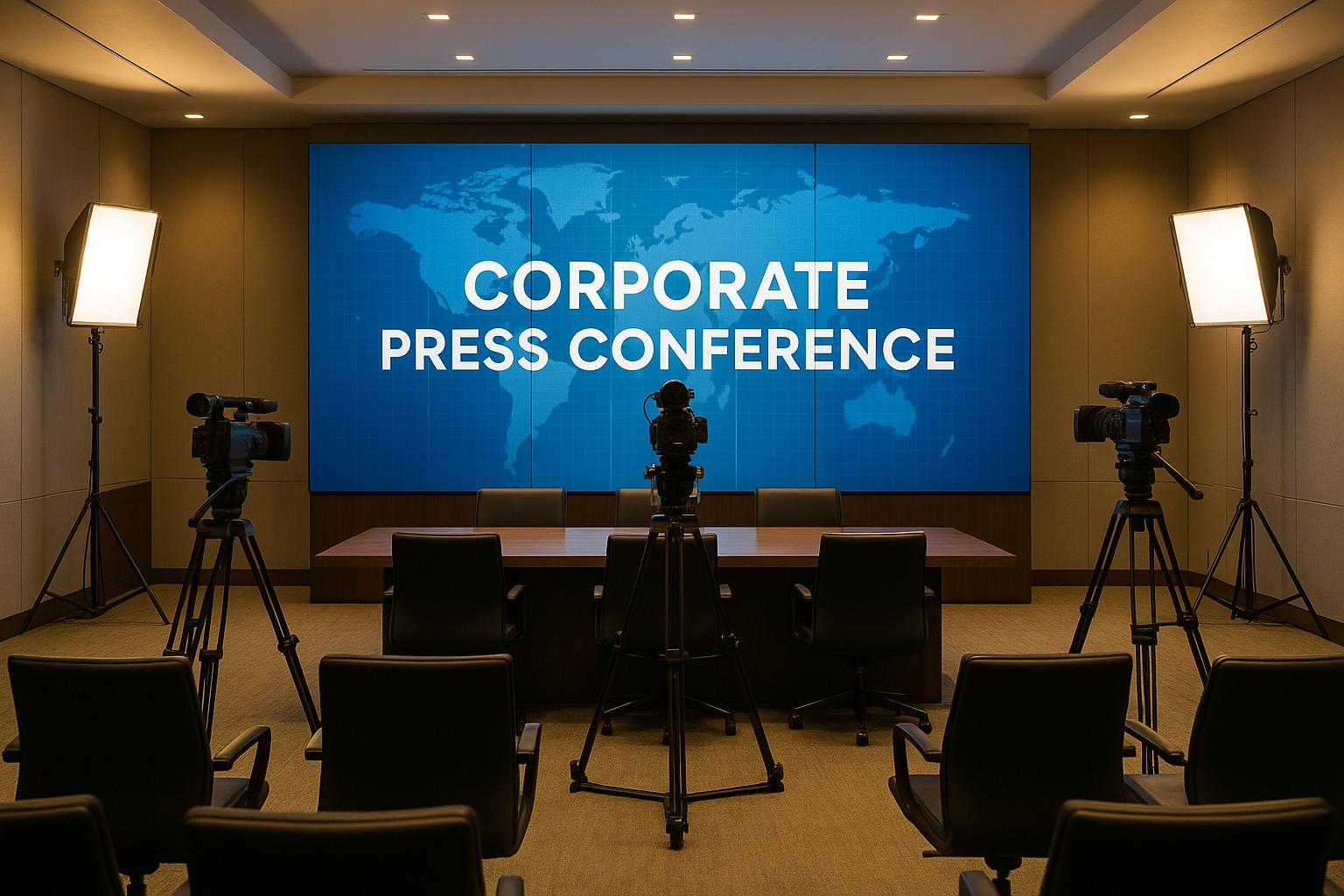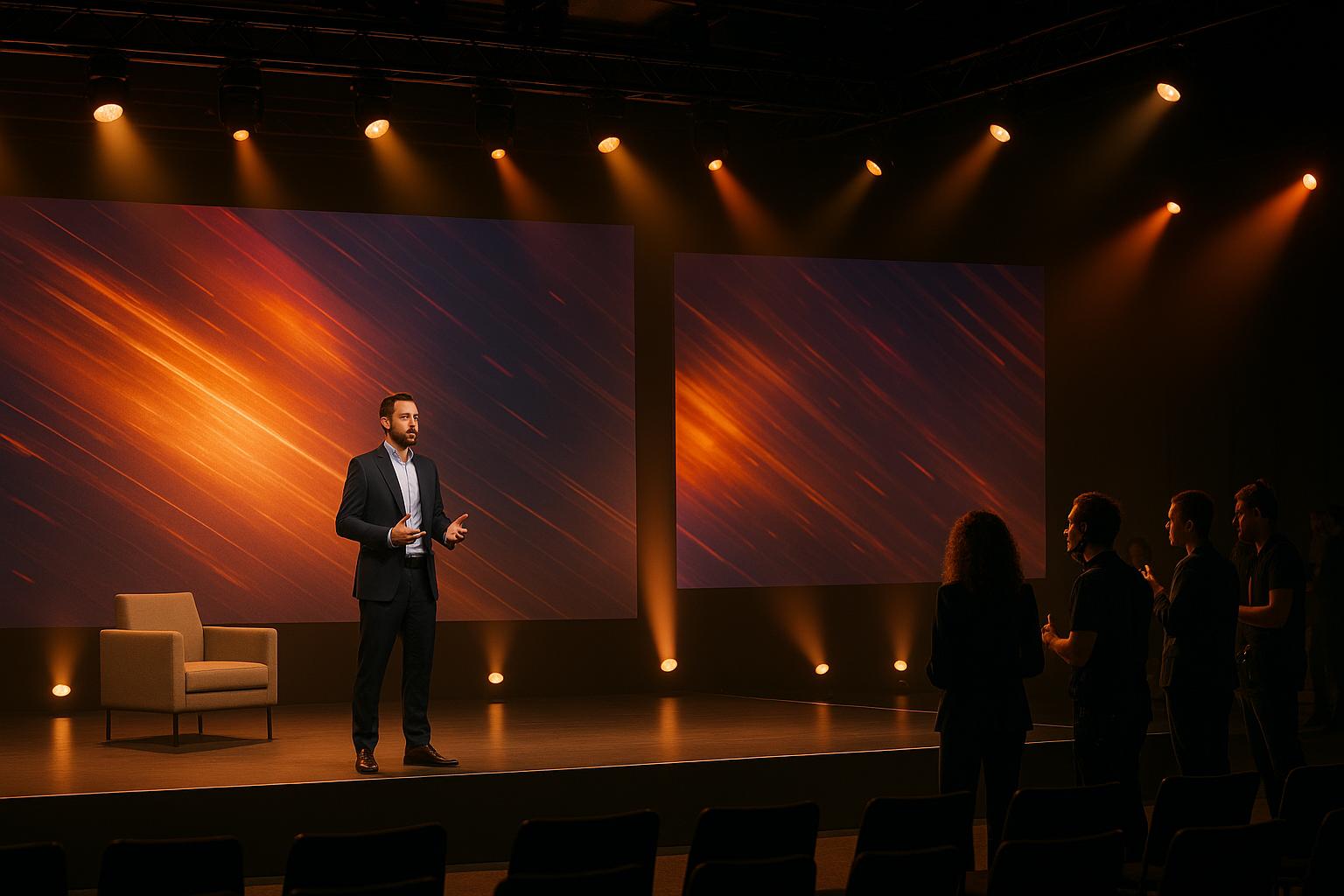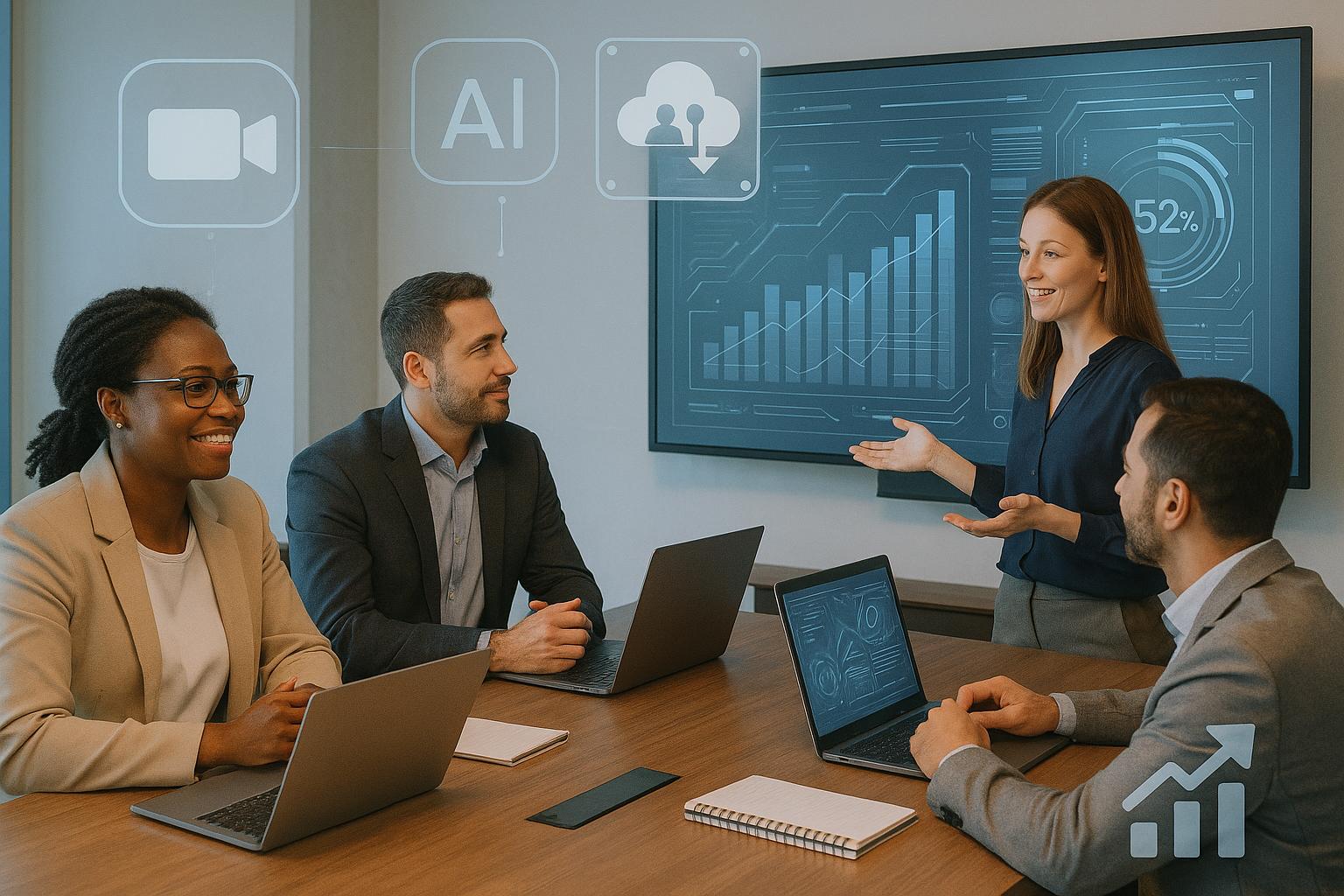Best Practices For Company Dealer Meetings

Chief Executive Officer

Dealer meetings are a direct way to strengthen partnerships and drive business growth. When planned effectively, they help businesses align goals, introduce new products, and motivate dealers to achieve better results. However, poorly executed meetings can lead to frustration and disengagement.
Key Takeaways:
- Preparation is critical: Clear agendas, proper AV setups, and engaging content are essential.
- Engagement matters: Use interactive tools, live polling, and recognition programs to keep dealers involved.
- Technical setup is crucial: High-quality sound, lighting, and modern AV tools ensure smooth communication.
- Actionable agendas: Focus on practical insights, timed sessions, and clear next steps for dealers to follow.
- Post-event analysis: Measure attendance, engagement, and ROI to improve future meetings.
Quick Tips:
- Share agendas 7–10 days in advance and update them 48 hours before the event.
- Use morning sessions for complex topics and keep presentations under 20 minutes.
- Recognize dealer achievements with awards tied to measurable metrics.
- Leverage tools like live streaming, mobile apps, and feedback systems for seamless execution.
- Partner with AV experts for professional production and support.
Dealer meetings are about equipping partners with the tools and motivation they need to succeed. By focusing on clear communication, technical excellence, and audience engagement, you can transform these events into powerful business drivers.
Setting Up AV and Technical Production
A solid technical production is the backbone of any successful dealer meeting. Even the most compelling content can fall flat if the sound is unclear or the visuals are subpar. A carefully planned audiovisual setup ensures your message resonates with every attendee in the room.
AV Setup Best Practices
For venues over 2,000 square feet, use directional microphones paired with distributed speakers to ensure clear audio. Always test microphones in advance and have backup wireless systems ready to avoid any interruptions.
Maintain a room temperature between 68°F and 72°F to keep equipment running smoothly and ensure attendees' comfort. Proper ventilation is key to preventing hot spots and maintaining a consistent environment.
Lighting is just as important as sound. Use LED fixtures adjustable between 3,200 and 5,600 K to eliminate shadows and glare. Position lights carefully to avoid casting harsh shadows on speakers or creating distractions.
For audiences of 50 or more, a 75-inch screen is the minimum recommended size. Larger venues may require multiple displays, and it’s essential to test sight lines to ensure everyone has a clear view.
A 12x24 ft stage works well for medium-sized meetings, offering enough space for movement and optimal camera angles. Also, make sure all equipment complies with U.S. 120V electrical standards to avoid compatibility issues.
Using Advanced AV Tools
Modern AV technology can take your event to the next level. For example, AI-powered tools can detect and fix audio feedback or video lag in under 10 seconds, ensuring uninterrupted presentations.
A 2024 survey revealed that 72% of U.S. event planners now rely on AI tools for tasks like troubleshooting and automatic sound leveling. These tools simplify complex AV management, making events run more smoothly.
Smart lighting systems can adjust brightness dynamically based on audience movement or the type of content being presented. Meanwhile, AI software offers real-time diagnostics, flagging issues like overheating projectors or low microphone batteries before they become problems.
Centralized cloud AV dashboards allow for seamless control, sending instant alerts to technicians for proactive fixes. These advanced tools, when integrated with professional AV services, create a seamless and professional experience for both in-person and remote attendees.
Corporate Optics' AV Production Services

Corporate Optics specializes in delivering tailored AV solutions for dealer meetings, managing everything from custom stage designs to live streaming that meets U.S. standards.
For meetings with 100 to 300 attendees, full-service AV production typically costs between $12,000 and $35,000. This includes professional-grade equipment, skilled technicians, and real-time troubleshooting for a worry-free experience.
They also provide HD live streaming with secure access and interactive Q&A features, ensuring remote participants stay engaged.
Speaker support options, like teleprompters, confidence monitors, and dedicated audio mixing, help presenters deliver polished and stress-free presentations. Additionally, modular backdrops paired with optimized lighting and camera setups create a professional atmosphere, whether the event is in-person or virtual.
Building a Clear Meeting Agenda
A well-structured agenda is the backbone of any successful meeting. Without clear objectives and thoughtful planning, even the most advanced AV setup or engaging speakers can't save a session from veering off course.
Once your AV setup is in place, focus on creating an agenda that drives meaningful discussions. Your agenda should aim to deliver measurable results and address key concerns, such as improving dealers' bottom lines and identifying growth opportunities.
Planning Time-Based Agendas
Timing is everything when it comes to effective meetings. Align your agenda with attendees' peak focus periods. For example, morning sessions between 9:00 AM and 11:30 AM are ideal for tackling complex topics like product launches or policy updates, as attention spans are sharpest during these hours.
To keep energy levels high, limit presentations to 15–20 minutes and include 5-minute transitions between segments. For full-day events, break the day into 90-minute blocks with 15-minute breaks. This structure prevents information overload and gives participants time to absorb key points.
Always build in a time buffer of 10–15%. If your main content takes 6 hours, plan for a 7-hour day to include breaks and transitions. This approach avoids the rushed feeling that can derail critical discussions.
Schedule meetings to accommodate dealers' needs. Sessions held Tuesday through Thursday, ending by 4:00 PM, allow many attendees to travel home the same day, making participation more convenient.
Matching Agenda Topics with Company Goals
Every agenda topic should tie directly to your company's objectives and dealer success. Start the meeting on a high note with performance recognition and success stories in the first 30 minutes. This sets a positive tone and shows appreciation for dealers' achievements.
Follow up with topics like new product launches or market opportunities while energy levels are still high. These are best addressed mid-morning, between 10:00 AM and 11:30 AM, when attendees are alert but not yet fatigued.
Policy changes or compliance updates should also be scheduled mid-morning, around 10:30 AM. These topics often require detailed explanations and plenty of time for Q&A.
Wrap up the meeting with action planning and next steps in the final hour. This ensures attendees leave with clear commitments and timelines, such as "Implementation deadline: March 15, 2026." Afternoon slots are great for training sessions or skill development, as interactive formats like group discussions and hands-on activities help combat the natural energy dip later in the day.
The ultimate goal? Equip dealers with actionable insights they can immediately apply.
Sharing Agendas Before the Meeting
Once your agenda is finalized, effective pre-event communication is key. Share the agenda 7–10 business days before the meeting, and send a final update 48 hours prior. This gives attendees time to prepare questions, review materials, and organize their schedules to prioritize key sessions.
Make your agenda detailed and actionable. For example, instead of listing "Q3 Product Launch", specify "Q3 Product Launch: Pricing Strategy, Competitive Positioning, and Sales Tools Available October 1, 2025." This clarity helps participants come prepared.
Assign pre-meeting tasks, such as reviewing inventory reports or gathering market feedback. These assignments transform attendees from passive listeners into active contributors, aligning their efforts with the meeting's objectives.
Include presenter details so attendees can submit questions in advance. This allows speakers to address common concerns during their presentations, reducing the need for rushed Q&A sessions.
Finally, send a polished agenda update 48 hours before the event. Include any schedule changes and precise session timings (e.g., "Registration and breakfast: 8:00–9:00 AM"). This ensures smooth transitions and eliminates confusion on the day of the meeting.
Keeping Your Dealer Audience Engaged
Even the best-planned agenda can miss the mark if your dealer audience isn’t actively engaged. Dealers often balance packed schedules and competing priorities, so it’s crucial to go beyond the typical presentation approach.
The key to engagement lies in understanding what your audience values. Dealers are looking for actionable insights they can apply immediately to boost revenue. They’re not interested in generic corporate messaging - they want real solutions to real challenges. When your strategies align with these needs, engagement naturally follows. Let’s dive into some practical ways to turn passive listening into active participation.
Encouraging Active Participation
To keep dealers involved, create multiple opportunities for interaction. For example, live polling during presentations can energize the room while providing instant feedback. You might ask, “What percentage of your Q4 sales came from our new product line?” or “Which training format would you prefer: video tutorials, printed guides, or live webinars?”
A structured Q&A system can also spark meaningful engagement. Instead of the usual “Any questions?”, ask something more specific like, “After hearing about the spring launch, what are your biggest concerns about inventory planning?” This approach not only encourages thoughtful responses but also uncovers shared challenges.
For longer sessions, consider small breakout groups of 4–6 participants. Assign each group a focused topic, such as brainstorming new strategies for customer retention, and give them 15 minutes to discuss. Afterward, have each group share their top takeaway with the larger audience. This method keeps discussions dynamic and collaborative.
Set clear participation guidelines upfront. Simple rules like turning phones to silent, closing laptops during presentations, and emphasizing that “all questions are valuable” can create a more focused and inclusive environment. A “no interruptions” policy during presentations, followed by dedicated discussion time, can further encourage engagement.
Leveraging interactive technology can also make a big difference. Tools like audience response systems allow dealers to anonymously submit questions, vote on priorities, or provide real-time feedback on new initiatives - making participation easier and more inclusive.
Adding Recognition Programs
Recognition programs are another powerful way to energize your dealer meetings. Celebrating achievements not only motivates individual dealers but also inspires the entire network to aim higher. Public acknowledgment during meetings creates a positive atmosphere and reinforces the behaviors you want to encourage.
Tie recognition to measurable performance metrics that align with your business goals. Categories like “Highest Year-over-Year Growth,” “Best Customer Satisfaction Scores,” or “Top Marketing Campaign Implementation” showcase tangible success and set clear benchmarks for others to aim for.
Peer-to-peer recognition can be especially impactful. Allow dealers to nominate colleagues for achievements like innovative problem-solving, outstanding teamwork, or exceptional support. These peer-driven awards often carry more weight because they come from those who truly understand the challenges of the business.
Timing is everything when it comes to recognition. Kick off your meeting with major annual awards to set an inspiring tone, or schedule smaller recognitions mid-meeting to re-energize the room during natural lulls. Keep these segments brief to maintain momentum while still making them meaningful.
Consider tiered recognition systems to celebrate a wider range of achievements. Categories like “Most Improved” or “Rising Star” ensure that more people feel included and motivated to participate.
Finally, pair recognition with tangible rewards. While plaques and certificates are always appreciated, practical rewards like exclusive training sessions, early access to new products, or invitations to special events can provide lasting value beyond the moment of acknowledgment.
Corporate Optics' Audience Engagement Tools
To take your engagement efforts to the next level, consider leveraging the advanced tools offered by Corporate Optics. Designed specifically for dealer meetings and corporate events, these tools provide real-time insights into attendee participation, helping you identify which parts of your presentation resonate most and which might need adjustment.
One standout feature is the platform’s ability to facilitate continuous feedback. Dealers can submit questions and comments via mobile devices throughout the meeting, creating a feedback loop that allows presenters to adapt their approach in real time and address key concerns as they arise.
Live streaming capabilities ensure that remote dealers can fully participate, contributing to discussions and Q&A sessions through integrated chat features. This ensures that no one feels left out, regardless of location.
After the event, detailed analytics reveal engagement patterns, highlighting which sessions sparked the most interaction, common themes in feedback, and participation rates across your network. These insights can be invaluable for refining future meetings and tailoring content to your audience’s interests.
Corporate Optics also offers speaker support services to help presenters deliver their messages with maximum impact. Features like custom polling and interactive tools ensure that every aspect of your meeting aligns with your objectives, keeping your dealer audience engaged from start to finish.
sbb-itb-ae35a94
Building Effective Presentations for Dealers
Dealer presentations should deliver clear, actionable insights that drive immediate results. Skip the unnecessary backstory and focus on what matters most to your audience.
The best dealer presentations emphasize practical takeaways. Show how new products can help close more sales, explain how pricing changes impact margins, and highlight the support tools available to improve performance. By addressing these specific concerns, you'll not only capture attention but also keep your audience engaged.
Customizing Content for Dealer Needs
Start by understanding the unique challenges dealers face in their respective markets. A rural dealer focused on agricultural equipment will have different priorities than one in an urban luxury market. Tailor your content to reflect these regional and market differences.
Back up your points with solid performance data rather than vague statements. Providing clear timeframes and explanations helps dealers see how the outcomes apply to their own operations. For example, if you're introducing a new product, include case studies or metrics that demonstrate its impact.
Tackle common pain points head-on. If inventory management is a frequent issue, dedicate part of your presentation to new tools or strategies to address it. Similarly, if customer retention is a challenge, offer actionable strategies along with measurable success indicators.
Make sure your content speaks to dealers of all sizes. Include sections that cater to small-scale operations as well as larger teams. This ensures that every attendee walks away with something relevant and useful.
Add immediate value by sharing insights like market trends, customer buying habits, and proven strategies for positioning products. These details can give dealers a competitive edge in their local markets.
Finally, structure your presentation around the dealer's customer journey - from the first interaction to post-sale support. Demonstrate how new initiatives fit seamlessly into their existing workflows to create a smoother, more effective process.
Using Effective Presentation Techniques
Once you've tailored your content, focus on delivering it effectively. Visual storytelling can make a big impact. Instead of relying on bullet points, use before-and-after scenarios to show dealer transformations. For example, a slide showcasing a dealership's performance improvement - supported by visuals - can tell a compelling success story.
Keep your slides clean and focused, with one main idea per slide. Use large fonts and high-contrast colors to ensure readability, even from the back of the room.
When presenting data, make it meaningful. Use charts or graphs to highlight key performance metrics over time, helping your audience see the story behind the numbers.
Engage your audience with interactive elements. Pose targeted questions to spark discussion and keep them actively involved. This not only personalizes the content but also makes the presentation more dynamic.
Every slide should pass the "So what?" test. If a detail doesn't directly add value or lead to actionable insights, consider revising or removing it.
Time management is critical. Allocate enough time to cover key points while leaving room for questions and discussion. This shows that you value dealer input and are open to addressing their specific concerns.
Wrap up each section with clear next steps. Don’t just present information - guide your dealers on how to apply it. Outline specific actions, deadlines, or resources they can use to implement your recommendations.
Speaker Support Services by Corporate Optics
Even the most well-prepared presentation needs a confident delivery. That’s where Corporate Optics comes in. Their speaker support services ensure your message is delivered smoothly and effectively.
They offer comprehensive rehearsal management to help presenters refine their delivery. From managing dealer-specific questions to optimizing timing and maintaining energy, their coaching prepares speakers for any scenario.
Technical rehearsals are another key feature. These sessions ensure that audiovisual elements - like interactive polls, videos, or live demos - run flawlessly. With this preparation, speakers can focus entirely on engaging the audience.
Corporate Optics also provides simulated practice environments where presenters can receive feedback on pacing, clarity, and engagement. This builds confidence and ensures a polished delivery during the actual presentation.
Additionally, their team offers real-time support during presentations. Technical staff are on hand to resolve equipment issues or make last-minute adjustments. After the presentation, their detailed analysis helps identify what worked and what can be improved, ensuring your future presentations are even stronger.
Using Tools and Technology for Event Management
When it comes to organizing dealer meetings, advanced tools and technology are essential for keeping everything running smoothly. These solutions help streamline processes, coordinate various elements, and ensure that every aspect of the event works seamlessly together.
Registration and attendee management platforms simplify the check-in process by automatically generating badges, tracking attendance, and sending reminders. These tools can also integrate with CRM systems to keep dealer contact details and preferences up to date.
Mobile event apps offer dealers instant access to agendas, speaker details, presentation materials, and networking features. These apps allow attendees to ask questions, participate in live polls, and access exclusive content during and after the event.
Live streaming technology is a game-changer for extending your event’s reach. It enables dealers who can’t attend in person to join remotely, ensuring they stay connected and involved.
Key Event Management Tools
Several tools can elevate your event planning and execution. Here’s a closer look at some of the most effective options:
- CRM platforms like Salesforce and HubSpot help track dealer interactions before, during, and after the event. They centralize information such as preferences, meeting history, and follow-up needs, making it easier to maintain strong relationships.
- Project management software such as Monday.com and Asana keeps planning teams on the same page with shared timelines, task assignments, and progress tracking. These tools are especially helpful when coordinating vendors, venues, and stakeholders across different locations.
- Video conferencing systems like Zoom and Microsoft Teams are ideal for hybrid meetings, offering features like breakout rooms, screen sharing, and recording options to support both in-person and virtual attendees.
- Survey and feedback tools such as SurveyMonkey and Typeform make it easy to gather dealer opinions right after sessions. Quick feedback forms can highlight what resonated most and pinpoint areas for improvement.
- Budget tracking apps help monitor expenses, categorize costs, and ensure financial accuracy, preventing budget overruns.
- Digital signage systems replace printed materials with dynamic displays that can be updated instantly. These screens provide real-time information like agenda changes, sponsor messages, and interactive wayfinding.
These tools not only simplify event planning but also provide valuable insights for refining future meetings.
Measuring Results After the Event
The success of a dealer meeting isn’t just about how it feels in the moment - it’s about measurable outcomes. Post-event analysis helps determine if your goals were met and identifies areas for improvement.
- Attendance metrics track registration, actual attendance, session participation, and no-show rates, offering a clear picture of turnout.
- Engagement data - such as session ratings, poll participation, and mobile app usage - reveal which content struck a chord with attendees.
- Lead generation tracking measures new opportunities created during the event, like follow-up meetings, product inquiries, or partnership discussions.
- Content consumption analytics show which presentations were most downloaded and which video segments were revisited, guiding future content priorities.
- Social media monitoring captures dealer sentiment and boosts your event’s impact through hashtag usage, shared photos, and positive mentions on platforms like LinkedIn and Twitter.
- ROI calculations compare event costs to tangible results, such as new dealer sign-ups, increased orders, or higher satisfaction scores.
- Feedback analysis dives deeper into dealer comments about logistics, content, networking, and overall value, offering actionable insights for the next event.
By leveraging this data, you can fine-tune your strategy and make future meetings even more impactful.
Working with Corporate Optics' Event Services
Corporate Optics takes event management to the next level by providing end-to-end solutions that seamlessly integrate technology into your dealer meetings. From initial planning to post-event analysis, their services ensure a flawless experience.
Their audiovisual production services cover everything from lighting and sound to video production. With technical rehearsals and on-site support, they ensure all equipment works perfectly, and presenters feel confident using it.
Live streaming services expand your event’s reach while maintaining high-quality broadcasts. Corporate Optics handles the technical details - like multiple camera angles, audio mixing, and stable internet connections - to support both live and on-demand participation.
They also offer integrated speaker support, ensuring smooth delivery across all sessions, and audience engagement tools like live polling, Q&A management, and mobile app integration to keep attendees actively involved.
For a memorable experience, their custom fabrication services create branded environments, from stage design to interactive displays, that reinforce your message and leave a lasting impression.
Finally, their post-event analytics provide a detailed breakdown of attendance, engagement, and content performance, helping you understand what worked and where there’s room to improve. With Corporate Optics, every detail is covered, ensuring your dealer meetings are both effective and unforgettable.
Conclusion: Key Points for Successful Dealer Meetings
Organizing a successful dealer meeting hinges on thoughtful planning, effective communication, and dependable technology. Sharing clear agendas ahead of time not only saves valuable time but also keeps attendees accountable and focused.
Preparation is critical. Using structured checklists can increase conversion rates by 28%, while poor planning contributes to a 67% failure rate. This highlights the importance of defining objectives and aligning logistics to achieve your meeting goals.
Strong communication is another cornerstone. Leveraging multiple notification channels and distributing agendas in advance ensures everyone is on the same page and ready to engage. It’s worth noting that attendee focus drops from 84% at the 30-minute mark to 64% by 45 minutes, so keeping meetings concise and engaging is key. A clear communication strategy paves the way for productive and seamless meetings.
Adding interactive elements and recognition programs can transform passive listeners into active participants. Recognizing top-performing dealers not only motivates but also nurtures stronger relationships. Meanwhile, interactive tools create memorable experiences that leave a lasting impression and reinforce your core message.
A reliable technical setup is non-negotiable. High-quality AV equipment, strong Wi-Fi, proper lighting, and advanced engagement tools ensure your content takes center stage. Partnering with experts like Corporate Optics can elevate your event with professional AV production, live streaming, custom staging, and post-event analytics, allowing you to focus on strategy while they handle the execution.
Finally, post-event analytics and ROI assessments are essential for refining future meetings. By evaluating outcomes, you can continuously improve and ensure each event surpasses the last in impact and effectiveness.
FAQs
How can I keep dealers actively engaged during company meetings?
Keeping dealers engaged during meetings requires creating an atmosphere that promotes open dialogue and active involvement. Begin by establishing clear expectations and cultivating a respectful space where participants feel at ease sharing their thoughts.
To keep the energy up, integrate interactive elements such as live polls, Q&A sessions, or breakout discussions. These not only make the meeting more dynamic but also encourage participation. Crafting an agenda that directly addresses the specific concerns or objectives of your dealers adds relevance and keeps their attention. Lastly, make sure presentations are short, visually engaging, and packed with actionable insights to ensure the audience stays focused and aligned with the meeting’s goals.
How can advanced AV technology improve dealer meetings?
Advanced AV technology can transform dealer meetings into more engaging and productive events. With top-notch audio and video systems, attendees can clearly see and hear presentations, paving the way for better understanding, stronger collaboration, and smarter decision-making.
Incorporating tools like high-resolution displays, directional microphones, and interactive technologies can bring presentations to life. These features not only capture the audience's attention but also ensure smooth communication, helping everyone stay aligned with the meeting’s goals.
What metrics should you use to measure the success of a dealer meeting, and how can reviewing results help improve future events?
To gauge the success of a dealer meeting, keep an eye on important metrics such as attendance rates, engagement levels, survey feedback from participants, and revenue impact. These indicators help you understand how effectively the meeting connected with your audience and supported your business goals.
Analyzing the event afterward is essential for making future meetings better. Look at factors like attendee satisfaction, social media activity, and the return on investment (ROI) to pinpoint strengths and areas for improvement. These insights can guide you in fine-tuning agendas, customizing presentations, and improving communication strategies to better align with dealer objectives.
Related Blog Posts









